The Museum Collections
Introduction
I. History and Art Collection
1. Icons of the 14th – 19th centuries
icons of the 14th – 17th century
2. Jewelry art of the 14th – 20th century
jewelry art of the 14th – 17th century
jewelry art of the 18th – 19th century
the european silver 14th - 19th centuries
3. Small-size sculptures (works of metal, wood, bone)
XI – the beginning of the XX century
Small-size sculptures 11th – 17th century
Small-size sculptures 18th – early 20th century
enamel of Troitza masters 15-8th – early 20th century
5.Embroidery, lace, textiles of the 14th - early 20th century
icon and ornamental embroidery
gold and silver lace
6.Painting of the 18th – 21st centuries
painting of the 18th – 19th centuris
painting of the 20th – 21st centuris
II.Manuscripts and old printed books of the 14th – 17th century
IV.Lithography of the 18th – 19th century
V.Numismatics
VI.Medals of the 18th - early 20th century
VIII.Archeology collection
IX. Russian folk and applied and decorative art of the 17th – 21st c.
1. Artistic wood
folk carved and painted wood
wooden toys
house carving of Sergiev Posad
Khokhloma and Gorodets painting
2. Artistic textiles
embroidery and weaving
printed textiles and lace
Russian shawls
folk costumes
folk garments
printed cotton kerchiefs
|
Folk garments collection (p. 1)
|
The collection of folk garments occupies an important place in Sergiev-Posad museum-preserve. It includes in their composition, both separate subjects, and full complexes of a daily, celebratory and ceremonial suit of Russian people, the people of Siberia, the Far East region. Basically, the collection is dated boundary 19th - 20th centuries, at the same time variety of exhibits concerns the middle, 2nd half 19th century (headdresses, ornaments).
Feature of this collection is that the most part of products was brought from the expeditionary inspections spent by several generations of scientific employees, since 1950 years and on the present. O.V.Kruglova and L.E.Kalmykova filled up collection with exhibits from Russian North, the Northwest and upper Volga region of the European Russia; V.M.Zhiguleva, L.M.Zaytseva, G.V.Sokolova from the territories located to the south of Moscow, S.V. Gorozhanina - from Priuralye region and Zavolzhye of Nizhniy Novgorod region. The collected materials about time and a creation place, features of manufacturing, connection in ensembles allow to disclose value of each subject in that stratum of national art culture from which it was withdrawn during expeditions.
The small amount of subjects of garments arrived in Sergiev-Posad museum-preserve from the Museum of national art crafts which was generated on the basis of the Exhibition of national creativity of 1937, widen in halls of the State Tretyakov gallery. In 1941 the Museum of national art crafts became department of Zagorsk museum-preserve.
Sergiev-Posad museum-preserve has possibility to show all basic types of lady's wear of Russian agricultural population: the most ancient, with homespun woollen skirt, remained to early 20th century in on the earths to the south of Moscow; and with a sundress which was the basic garments of Russian peasants in northern and Middle - Russian provinces, and also at later immigrants 17th-18th centuries on South Russian open spaces in connection with colonization of a wild field.
|
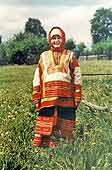
Female celebratory costume. Late 19th – early 20th century. Penza province |
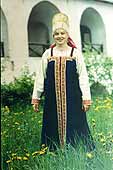
Maiden celebratory costume. Late 19th – early 20th century. Arkhangelsk province. |
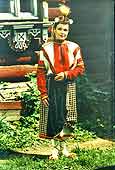
Maiden celebratory costume. 1920th. Tambov province |
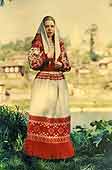
Costume promised bride. Late 19th – early 20th century. Vologda province |
|
The ethnic composition of inhabitants of southern boundary fortresses, has abates and sentry posts was non-uniform since they were settled both on monarchic decrees, and on a free basis. Besides, the local population known from time immemorial, and carrying homespun woollen skirt here continued to live.
Privileges which were received from these service class involved here natives because of the Lithuanian boundary: Poles, Lithuanians, Ukrainians and the Byelorussians keeping adherence to habitual forms of folk garments on a new place. So was extended a female costume with a skirt in a longitudinal strip - andarack, known to early 20th century in Penza, Tambov, Oryol, Kursk, Voronezh and other provinces through which in 17th century there took place southern border of Russian state.
Rich and various collection of the Sergiev-Posad museum gives ample opportunities of display of children, maiden wedding, ceremonial and daily lady's garments in several variants. This is because in remote Russian villages to middle 20th century homespun woollen skirt and sundresses wearied constantly, and here and there till the late of 20th centuries dressed ancient clothes for weddings and commemoration. And as at the time of grandmothers, having seen the woman in that or other dress it was possible to define with confidence its origin, family, a financial position, a spiritual condition and many other things.
|
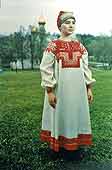
Female wedding costume. Late 19th - early 20th century. Tver province. |
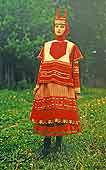
Female wedding costume. 1920th. Tambov province |
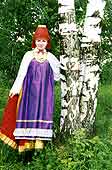
Female wedding costume. Early 20th century. Kursk province |
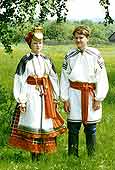
Man's and female wedding costumes. 1920th. Voronezh province. |
So in South Russian settlements the girl almost before wedding went in one shirt added with a pattern corbel. Its hair braided in one plait, decorated tape or narrow forehead bandage. On reaching majority over a shirt dressed linen clothes “suprun, or shushka” without which it was impossible to go out of doors.
Homespun woollen skirt dressed in these edges, as a rule, before wedding or after wedding. Homespun woollen skirt symbolized transition in an adult married life, as well as a female headdress under which followed hide each hair.
The maiden costume, costume s of married women, garments of older persons and widows strictly differed in Russian village of late 19th – early 20th century For example, in settlements on the Vychegda-river girls wearied straight round sundresses in a red cage. While women are more senior - sundresses of the same cut, but from dark blue checkered linen. In Velikiy Ustyug town of the Vologda province before early of 20th century promised girl dressed the white-red dress set with fertility symbols on a shirt, an apron and a kerchief.
|
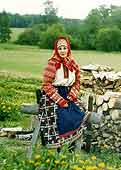
Female celebratory costume. Late 19th - early 20th century. Smolensk province. |
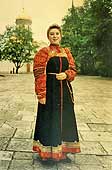
Maiden celebratory costume. Late 19th - early 20th century. Smolensk province |
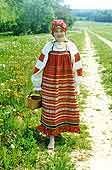
Female celebratory costume. 1920th. Tambov province |
|


